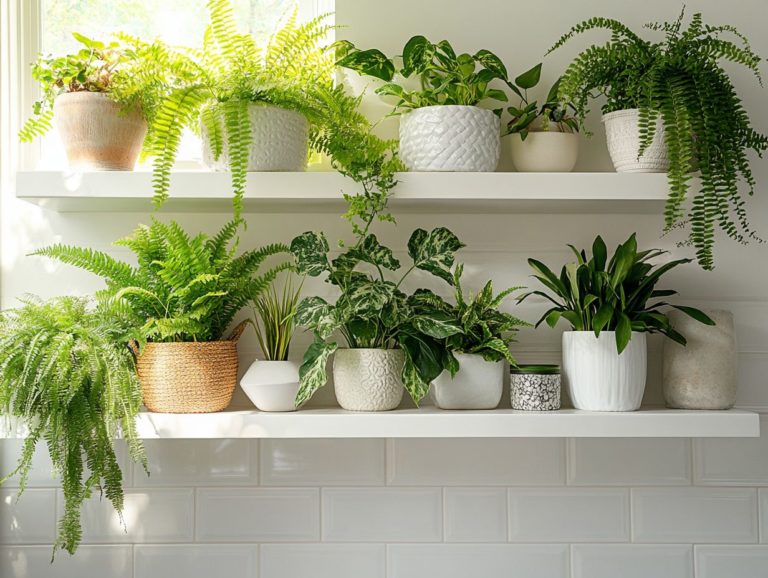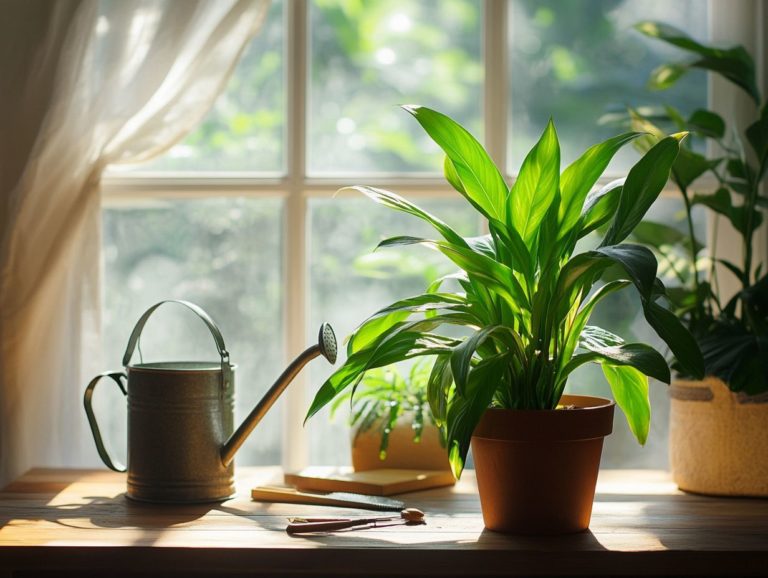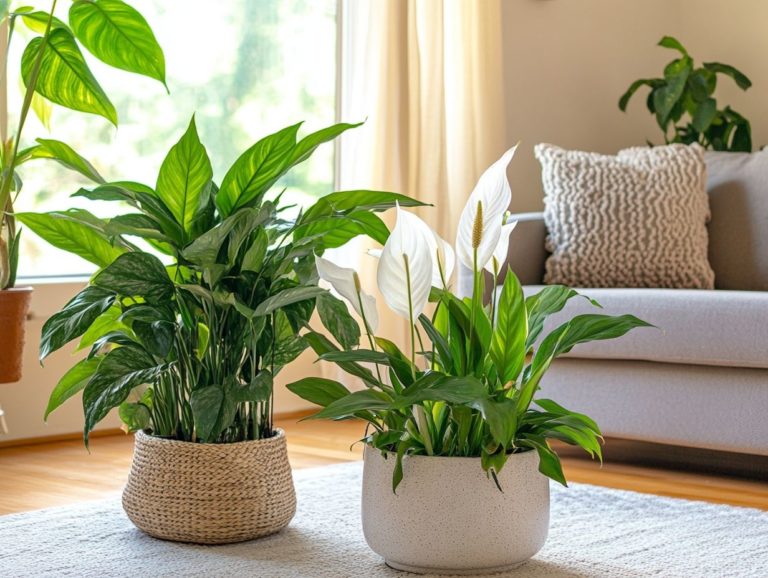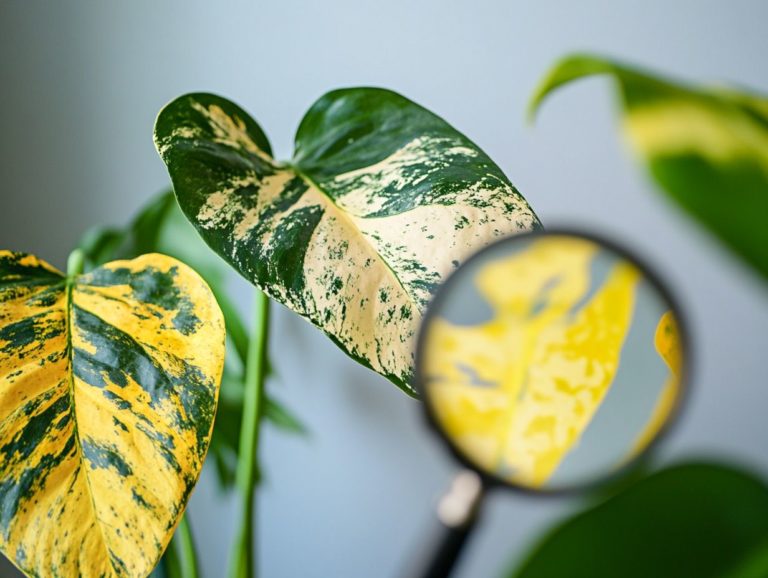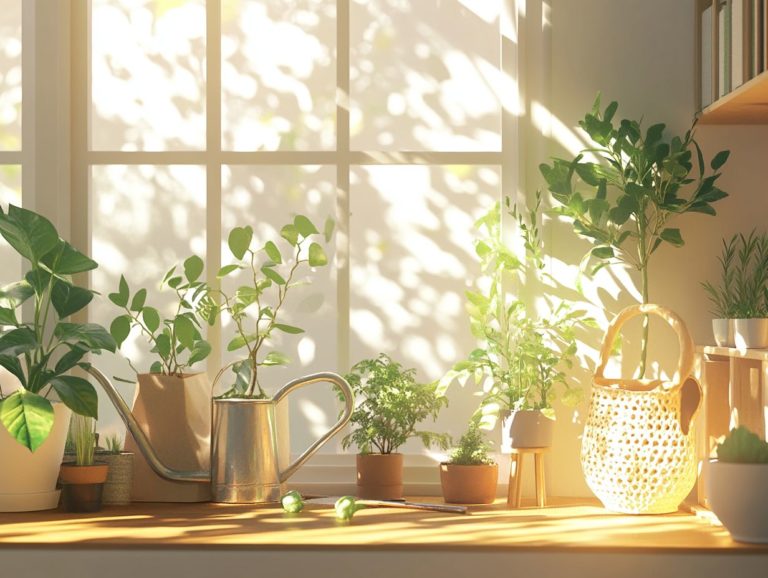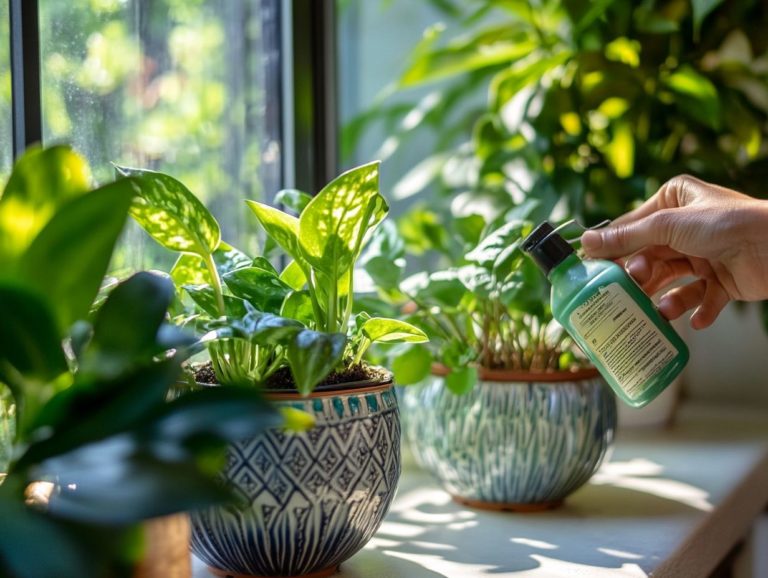How to Avoid Overwatering Indoor Plants?
Watering seems simple, but it s an art that can decide your indoor plants’ fate. Proper watering is essential for houseplant care.
While many worry about underwatering, overwatering can cause root rot and other serious issues. This can put your plants’ health at great risk.
In this guide, you’ll learn about proper watering techniques. You’ll also discover signs like yellow leaves and mushy growth that indicate overwatering.
Find out common mistakes and effective tips to revive those droopy leaves. Dive into this knowledge to help your plants thrive!
Contents
- Key Takeaways:
- Understanding Proper Watering
- Signs of Overwatering
- Factors that Contribute to Overwatering
- Preventing Overwatering
- How to Revive Overwatered Plants
- Frequently Asked Questions
- 1. What is the best way to avoid overwatering indoor plants?
- 2. How often should I water my indoor plants to prevent overwatering?
- 3. What are some signs that my indoor plant is being overwatered?
- 4. Can using a self-watering system help prevent overwatering indoor plants?
- 5. How can I save an overwatered indoor plant?
- 6. Are there any specific techniques to help prevent overwatering indoor plants?
Key Takeaways:
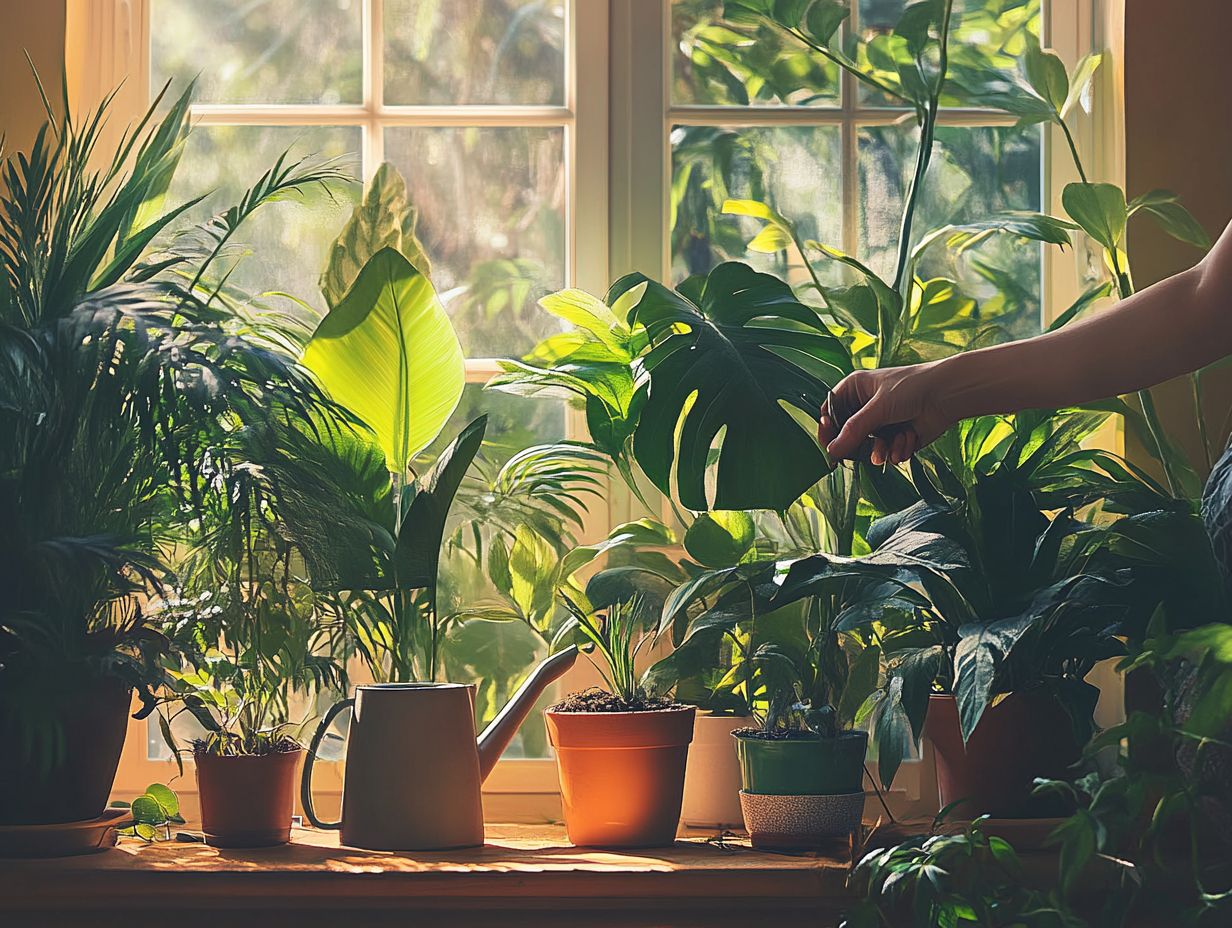
- Proper watering is crucial. Overwatering can harm your plants and lead to root rot.
- Signs of overwatering include yellowing leaves, mushy growth, wilting, and moldy soil.
- Factors like potting material and drainage holes affect overwatering. Knowing these can help prevent issues.
Understanding Proper Watering
Knowing how to water your plants properly is vital. Each plant has unique needs influenced by soil moisture, weather, and season.
Effective watering techniques help your houseplants thrive. This prevents frustrating issues like root rot and yellow leaves.
Why Overwatering is Harmful
Overwatering is a serious mistake in houseplant care. It can lead to root rot and overall plant health issues.
Too much water saturates the soil, blocking air circulation vital for roots. This suffocates them and can cause decay.
This issue is especially harmful for cacti and succulents, which thrive in dry conditions.
Act quickly if you see symptoms like mushy stems, yellowing leaves, or foul odors. For example, an overwatered succulent may look plump and soft, while a cactus may develop dark spots at the base.
To check if a plant struggles with excess moisture, examine the soil consistency and observe its growth. Use well-draining soil and let pots dry between waterings to mitigate the risk of overwatering.
Signs of Overwatering
Recognizing the signs of overwatering is crucial for preserving your indoor plants’ health. Look for yellowing leaves and mushy growth.
Mushy growth also indicates root rot, so immediate action is essential. By spotting these symptoms early, you can intervene quickly and help restore your plant’s health.
Identifying Symptoms in Different Types of Plants
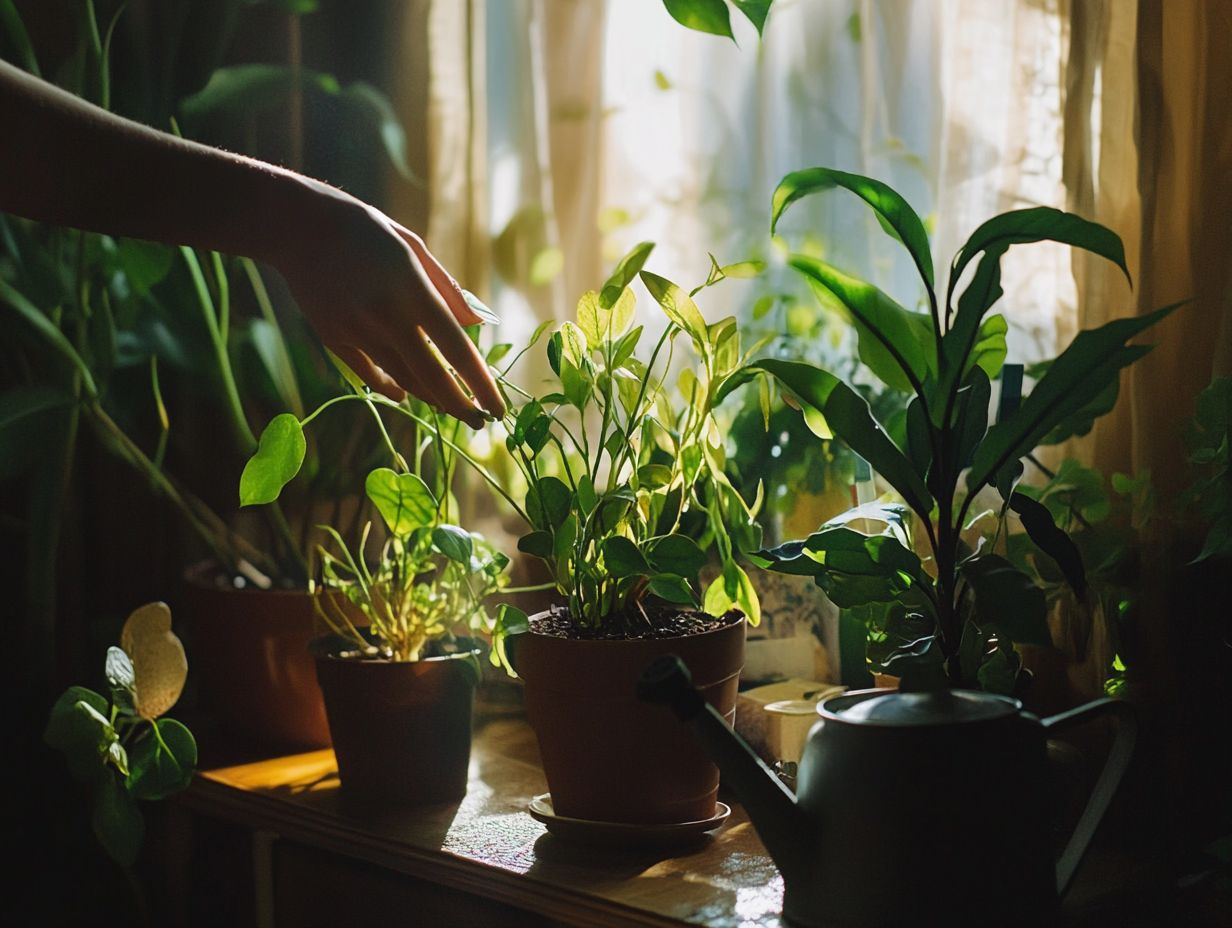
Symptoms of overwatering can manifest quite differently across various types of plants. It’s essential to understand how each species responds to excess moisture, including carnivorous plants like the Pitcher Plant. Traditional houseplants might present with yellow leaves and mushy stems. In contrast, the Pitcher Plant may show symptoms indicating overwatering.
Succulents, known for their water-storing capabilities, may develop translucent leaves that look swollen or even ooze, signaling a potential issue. Aloe vera plants can also indicate distress by softening at the base and emitting a foul odor due to root rot.
Identifying these symptoms early is crucial! Regularly checking soil moisture levels with a moisture meter a tool that measures soil wetness and adjusting your watering schedule according to each plant’s unique needs can help.
Understanding these nuances aids in maintaining plant health and enriches your experience of nurturing a diverse array of flora, including your favorite ZZ plant, Parlor Palm, and Money Tree.
Factors that Contribute to Overwatering
Several factors can contribute to overwatering, jeopardizing the health of your cherished houseplants. Key elements include inadequate drainage holes in pots, soil that struggles to retain moisture, and insufficient air circulation around the roots, all leading to root rot.
These issues create an environment that is less than ideal for your plants, especially for houseplants and succulents. By understanding these factors, you can develop effective watering strategies and plant care tips, such as how to maintain soil moisture for indoor plants, to keep your green companions thriving and ensure optimal plant health.
Common Mistakes and Misconceptions
There are numerous common mistakes and misconceptions about watering plants, particularly regarding houseplant care, which can lead to serious issues like root rot. For instance, thinking all plants need daily watering can lead to an overwatering disaster. Neglecting specific needs of certain species, like cacti and aloe vera, which thrive in drier conditions, can harm them.
Every houseplant does not flourish under the same environmental conditions. Factors such as sunlight exposure, humidity levels, and seasonal changes significantly impact their water needs. Familiarizing yourself with each plant’s specific requirements and performing a simple moisture check using the finger test can prevent overwatering. For optimal care, consider learning about the best watering techniques for indoor plants. This practice fosters healthier growth and ensures each plant receives the unique care it deserves.
Establishing a consistent yet adaptable watering schedule tailored to each plant s habits can transform your space into a lush oasis of greenery, balancing moisture with the needs of each species.
Preventing Overwatering
Preventing overwatering is essential for maintaining the health of your indoor plants, including Sansevierias and ZZ plants. Adopting best practices can greatly enhance their longevity and vitality.
Key strategies include:
- Monitoring soil moisture levels closely.
- Ensuring your pots have proper drainage holes.
- Recognizing the unique watering needs of different plants, such as cacti and aloe vera.
For instance, ZZ plants and succulents flourish under specific conditions. Tailoring your approach can make all the difference in maintaining healthy growth!
Best Practices for Watering Indoor Plants
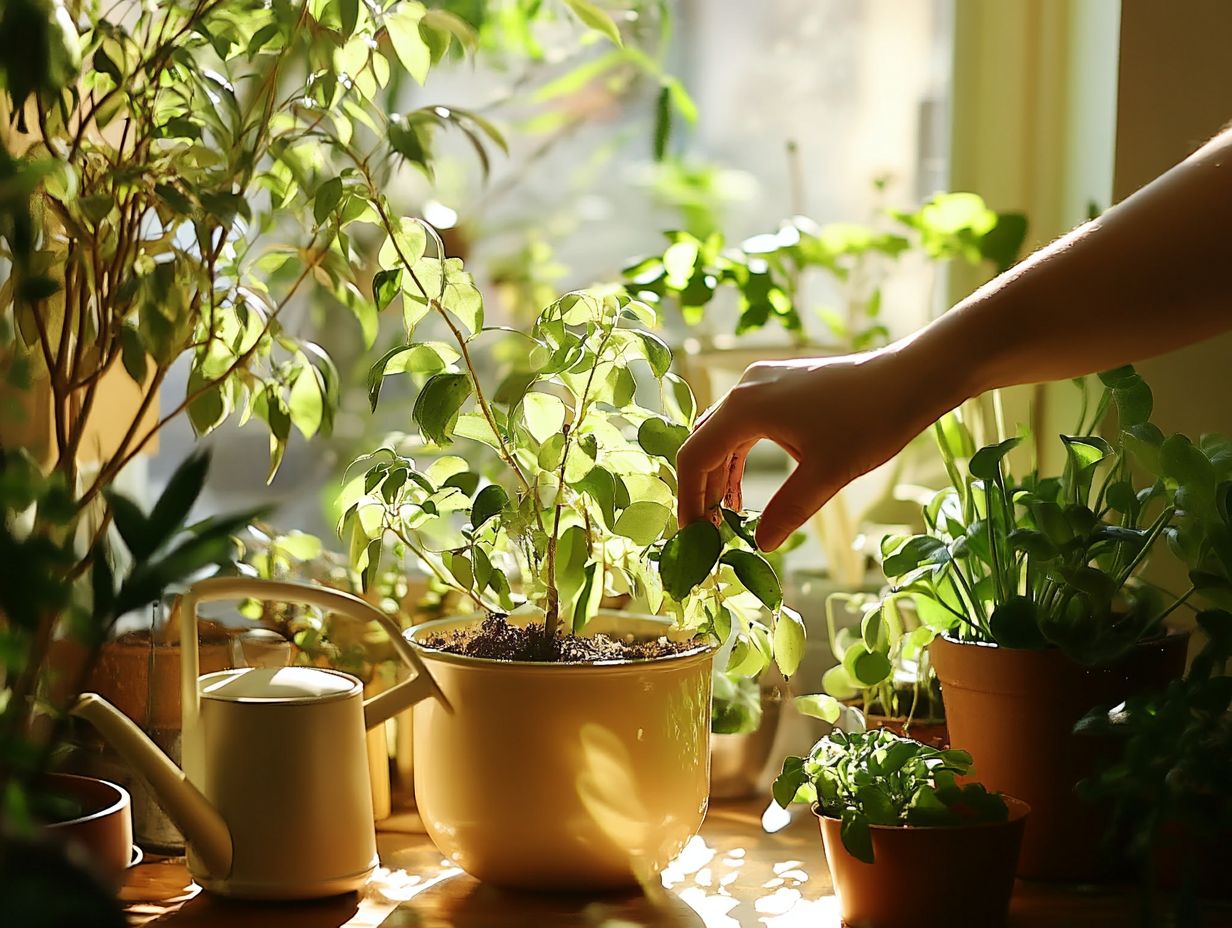
Employing best practices for watering your indoor plants can significantly enhance their health and growth. This reduces the likelihood of root rot.
Use techniques like the finger test to check the soil moisture level and see if it’s time for a drink. You can also utilize a moisture meter, which is a device that measures how wet the soil is, or water dispensers. To avoid the common pitfalls of overwatering, be sure to learn about the top 7 mistakes in watering indoor plants. These methods help maintain optimal hydration.
It’s essential to adjust your watering frequency based on each plant’s specific needs. For instance, succulents and cacti thrive in drier conditions and require less frequent watering. In contrast, tropical plants appreciate more consistency in moisture, so learning how to water your indoor garden correctly is key to their health.
Seasonal changes are crucial. Different plants adapt to various environmental conditions. During the warmer months, increased evaporation might mean your plants need a more regular watering schedule. Monitor both moisture levels and environmental factors.
In cooler seasons, most plants typically require less hydration. Keep an eye on environmental factors such as humidity, sunlight exposure, and soil moisture to refine your watering strategies. Understanding the science of watering indoor plants ensures each plant receives the precise care it needs to thrive.
How to Revive Overwatered Plants
Reviving overwatered plants demands immediate attention and a thoughtful approach to restore their health and vitality. Begin by assessing the level of root rot; this is crucial for the recovery of your beloved plants.
Act quickly! Gently remove the plant from its pot, taking care not to damage the roots. This step is vital for their recovery and future health. Allow the roots to dry out before repotting in fresh, well-draining soil. To ensure optimal care, learn how to properly water indoor plants in soil. This new environment supports air circulation and moisture levels, essential for promoting recovery.
Steps to Help Plants Recover
To effectively assist your overwatered plants in their recovery, several essential steps must be taken. First, ensure proper drainage and promote air circulation around the roots. These elements are crucial for both recovery and overall plant health, especially for indoor plants.
Once you’ve addressed these foundational aspects, gently remove the affected roots. Trim away any that appear blackened or mushy; these cannot bounce back and could further impact plant health.
Repotting your plant in fresh, well-draining soil is of utmost importance. Consider using a mix specifically tailored to your plant type, such as one suited for succulents, to encourage vigorous growth. Ensure the pot allows excess water to escape, preventing future complications and maintaining the right moisture balance for your plants.
After repotting, monitor soil moisture with care. Allow it to dry out between waterings, but avoid letting it stay completely dry for too long. This ensures that the water level remains optimal for recovery.
Regularly inspect the leaves for signs of new growth. This will provide valuable insights into your plant’s recovery progress and help gauge if your watering techniques are effective.
Frequently Asked Questions
1. What is the best way to avoid overwatering indoor plants?
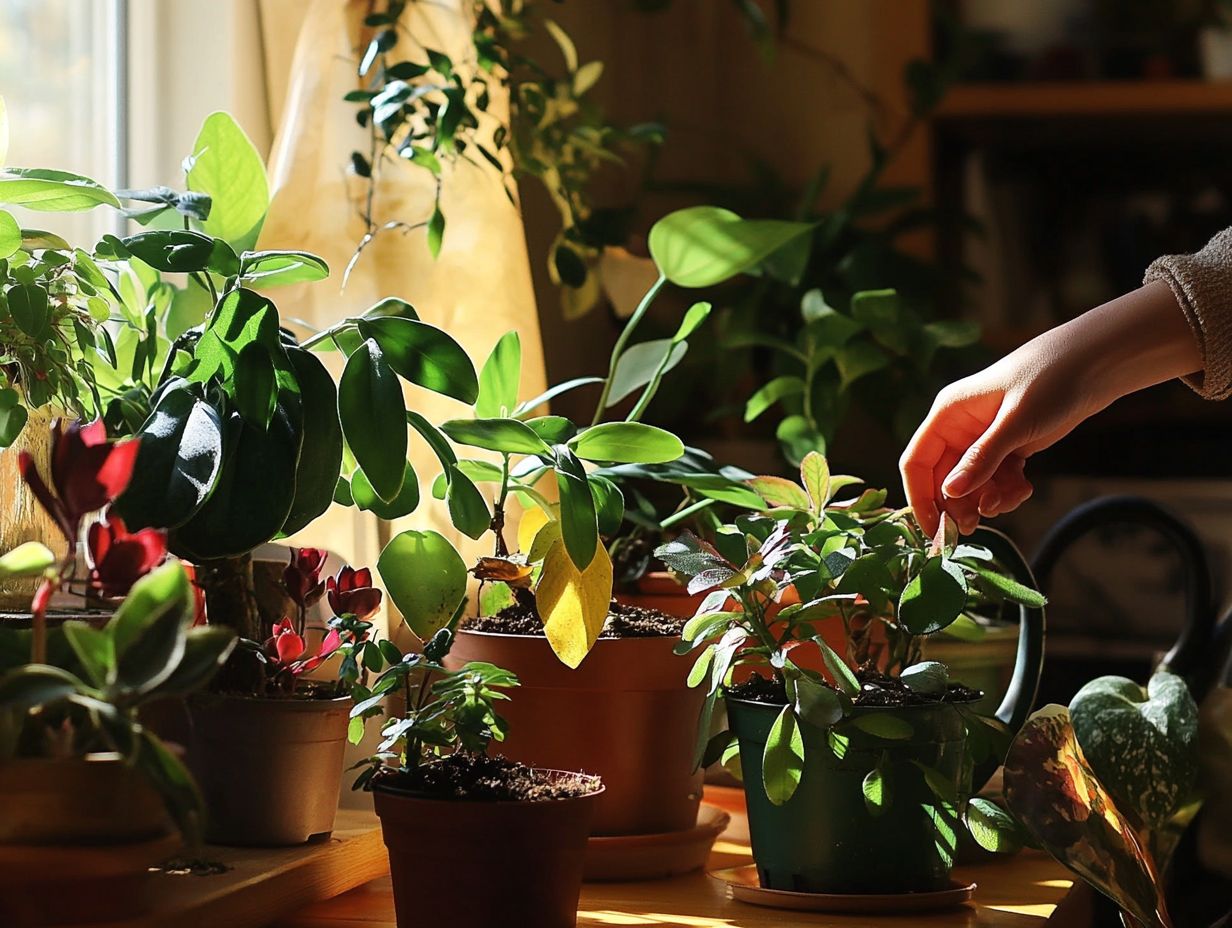
The best way to avoid overwatering indoor plants is to create a watering schedule based on each plant’s specific needs. Research your plant type and its watering requirements, then stick to a consistent schedule.
2. How often should I water my indoor plants to prevent overwatering?
The frequency of watering depends on various factors like the type of plant, pot size, and humidity levels. Generally, most indoor plants should be watered once or twice a week. However, it’s important to check the soil moisture levels before watering.
3. What are some signs that my indoor plant is being overwatered?
If your indoor plant is overwatered, stop watering immediately. Allow the soil to dry out completely.
Gently remove the plant from the pot. Check for any signs of root rot.
If you find rotting roots, trim them away. Repot the plant in fresh soil.
4. Can using a self-watering system help prevent overwatering indoor plants?
Wondering if a self-watering system can save your plants? It can provide just the right amount of water, helping you avoid overwatering!
Always check the soil and adjust your watering schedule as needed.
5. How can I save an overwatered indoor plant?
Don t wait! If you see signs of overwatering, act fast to save your plant!
Stop watering and allow the soil to dry out. Gently inspect the roots for any rot.
If you find any affected roots, trim them away and repot the plant in fresh soil.
6. Are there any specific techniques to help prevent overwatering indoor plants?
One popular technique is the “finger test.” Stick your finger about an inch deep into the soil to check for wetness.
If it feels dry, it’s time to water. Another method is to use a moisture meter.
A moisture meter is a tool that tells you how wet or dry the soil is, giving you a clearer picture of your plant’s needs.

